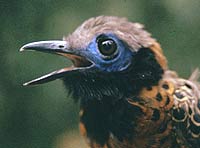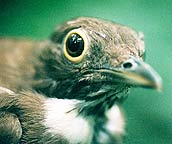Dawn Chorus
Posted on January 14th, 2009 - 10:30 AM Each week we write about the science behind environmental protection. Previous Science Wednesdays.
Each week we write about the science behind environmental protection. Previous Science Wednesdays.
 About the Author: Karl Berg is currently a Ph.D. student at Cornell University in Ithaca, NY, and is looking forward to a career that will combine his interests in animal behavior and conservation. His master’s research was funded by an EPA Science to Achieve Results (STAR) Graduate Research Fellowship.
About the Author: Karl Berg is currently a Ph.D. student at Cornell University in Ithaca, NY, and is looking forward to a career that will combine his interests in animal behavior and conservation. His master’s research was funded by an EPA Science to Achieve Results (STAR) Graduate Research Fellowship.
Bird populations have long been viewed as “canaries in the coal mine” for indicating changes in environmental health. As EPA’s Report on the Environment states, “changes in bird populations reflect changes in landscape and habitat, food availability and quality, toxic exposure, and climate.” Because this is so important, annual bird counts to document population changes are conducted by the North American Breeding Bird Survey.
If the timing of the species’ calls is staggered, birds could be undercounted, which is why I wanted to find an improved method to monitor bird populations to better understand how they are changing and why.
 In my quest to understand the “dawn chorus,”—why different bird species chime in at different times—I chose my research site in the tropical forests of Ecuador where hundreds of bird species occur together. Tropical forests are the most threatened terrestrial ecosystems on Earth and have large and diverse bird populations. As more forests are cut one immediate change that takes place in remaining forests is the quantity and quality of forest light.
In my quest to understand the “dawn chorus,”—why different bird species chime in at different times—I chose my research site in the tropical forests of Ecuador where hundreds of bird species occur together. Tropical forests are the most threatened terrestrial ecosystems on Earth and have large and diverse bird populations. As more forests are cut one immediate change that takes place in remaining forests is the quantity and quality of forest light.
My study showed that common communicative and reproductive behaviors of forest birds are synchronized or have co-evolved with seemingly tiny changes in forest light.
My wife and I spent several months trudging up muddy, forested mountains in a tropical rainforest of Ecuador at 4:00 AM to make over 100 hours of recordings, synchronized with twilight, to determine if the birds had a singing schedule.
 Back at Florida International University, we identified 130 bird species from the recordings and logged the times of 25,000 songs. My research showed that tropical birds began to sing only when they saw light. Big-eyed birds that foraged high in the forest canopy sang earlier. The late risers were birds with small eyes in the dark, dense underbrush. The control mechanism then, was a combination of ecological and morphological traits synchronized with an atmospheric one.
Back at Florida International University, we identified 130 bird species from the recordings and logged the times of 25,000 songs. My research showed that tropical birds began to sing only when they saw light. Big-eyed birds that foraged high in the forest canopy sang earlier. The late risers were birds with small eyes in the dark, dense underbrush. The control mechanism then, was a combination of ecological and morphological traits synchronized with an atmospheric one.
In the future, I believe that automated birdsong monitoring, supplemented by the sophisticated understanding of birdsong timing, will help EPA and others better understand our changing environment.
Tags: birds
| Permalink | TrackBack
January 14th, 2009 at 11:23 am
That’s fascinating! Good luck with your research. For how long did you travel through the rainforest? Notice any changes during that time?
[Reply]
January 15th, 2009 at 12:05 pm
This is a great post! I never thought about how the sounds of the birds are related to daylight. Around our house here in the beautiful lush karst zone of Puerto Rico non-native”guacamayos” like to fly as the sun rises and make a lot of noise. I have noticed however that smaller native species prefer broader light while others like owls prefer the night. I will be on the lookout! I learned something new today!
[Reply]
January 15th, 2009 at 2:47 pm
It took me years to figure out that bird ‘watching’ should really be called bird ‘listening.’ A good ear is far more important than good binoculars. It’s great to see that a good ear may now be a clever way to monitor environmental change.
[Reply]